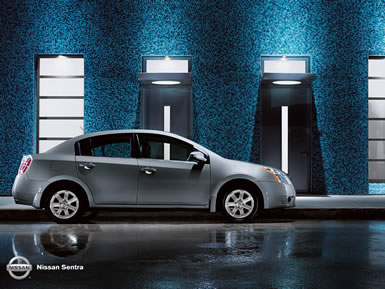|

Nissan Sentra
Review: The Sentra used to be Nissan's smallest and cheapest car. In
recent years it's grown bigger and become more cushy, leaving room at
the bottom of Nissan's lineup for the new Versa.
This follows the trend
of a lot of compact cars. The Honda Civic spent too much time at the
all-you-can-eat bar, so it was replaced by the Fit. The Toyota Corolla
gorged itself on holiday sweets, so the Echo, and later, the Yaris, took
its spot on the cheap list.
This leaves today's
Sentra in an interesting position. It used to be Nissan's economy car,
so it gets great gas mileage and drives with the spunk of a low-cost
runabout. But at the same time it's become a much more mature vehicle
with a quiet cabin and controlled, unflustered ride. It's turned into a
grown-up car.
First of all it's
designed to be efficient, not muscular, with a small, 2.0-liter
4-cylinder engine that makes 140 horsepower and gets 33 mpg on the
highway. Routed through a continuously variable transmission, the Sentra
doesn't feel underpowered, but the acceleration is far from exciting.
The driving feel is far
smoother than you'd expect in a car this size. It's not harsh or rough
like a lot of compact cars, with a soft suspension that's perfect for
effortless highway cruising. It can be fun to drive when you really push
it, but it's designed more for comfort than sportiness.
If it's excitement you
want, you'll be much happier with a high-performance version of the
Sentra called the SE-R. It comes with a more powerful engine and much
firmer suspension for more precise handling.
Inside the Sentra's
cabin is a surprisingly nice space. Soft-touch materials on the dash
feel like they could belong in an Audi or Volkswagen, the companies that
have made the best automotive interiors in recent years. The back seat
feels a bit cramped compared to other cars in this compact class, but
the front seats are perfectly comfortable.
Storage space is a big
plus in the Sentra. It has a lot of simple but innovative features that
make it more practical, like cup holders that are adjustable for
different size containers, and a trunk divider that can split the
storage space into two different compartments. It makes the best use of
the available volume.
Pricing starts at
$16,730 for the base model. A better-equipped Sentra S costs $17,760
with an automatic transmission, while the more luxurious Sentra SL
starts at $19,660.
What was tested?
The 2009 Nissan Sentra SL with a base price of $19,660. Options on the
test car: a set of Splash guards for $140, floor mats for $165, trunk
divider at $150 and the Premium Plus package for $850. Total MSRP price
as tested including the $695 destination charge: $21,660.
Why avoid it?
It's not particularly powerful, and the styling is dull.
Why buy it? It's
smooth and efficient, with a soft suspension that feels great on the
highway and a small, fuel-sipping engine that gets 33 mpg.
Bottom line: The
Sentra is no longer the smallest and cheapest car in Nissan's lineup.
It's become a grownup car now, with a smooth ride, a nice cabin and an
efficient engine that make it a great compact car for highway cruising.
By Derek Price © AutoWire.Net - San
Francisco
Nissan Sentra Review
provided by Tony Leopardo ©AutoWire.Net

Nissan Home Page
Column Name: The
compact Nissan grows up
Topic: The 2009 Nissan
Sentra
Word Count: 609
Photo Caption: The
2009 Nissan Sentra
Photo Credits: Nissan
Sentra Internet Media
Series #: 2009 - 48
Download
the Microsoft Word version here: 2009
Nissan Sentra
Download the Original Image File here:
2009 Nissan Sentra


|
